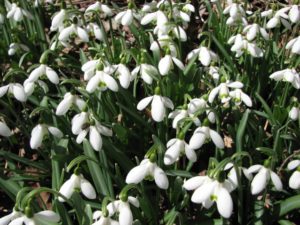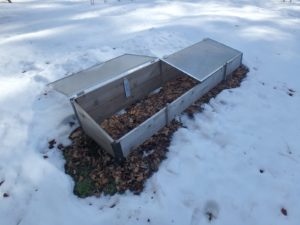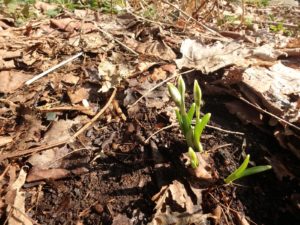
Snowdrops are the first flowers to bloom for me
On February 24 this year I went to my vegetable garden with a snow shovel. It was a warm, sunny day, and I was ready for spring. Now people say that old timers like me are more patient than young whipper-snappers, but I’m not sure that’s true. We have less time left on the planet, so some of us want lettuce and spinach from the garden sooner.
Obviously I knew that I couldn’t just shovel snow and plant. But I have a nice cold frame, and I wanted to set it on the soil and allow it to melt ice and snow, and get the soil warming up on sunny days for late March planting. I shoveled off about a foot of snow, and put the cold frame in place. An hour later my thermometer inside read 70 degrees!
My cold frame is one I got from Gardeners Supply. It is 8 feet long, 2 feet wide and is made of cedar planks with a polycarbonate lid that is set on an angle. The lid is hinged and can be left up on a stick to vent some heat on a sunny day, or it can be completely opened in summer.
My grandfather always had cold frames to extend the seasons, and he built his own out of planks and old storm windows. I’ve done that, too, but this light-weight and sturdy cold frame was quick and easy to assemble and to store in my barn after use.

This simple cold frame from Gardener’s Supply can be assembled in an hour
The slanted top should face south or east for maximum solar gain. The cedar panel at the front of mine is 8 inches tall, the back is 15 inches tall. That allows morning sun to get in through the slanted top.
I’ve also used my cold frame as a hot box. A hot box is a growing space that is heated by fermenting horse manure. When using the frame as a hot box, I dig a pit 18 inches deep the size of my cold frame and line the hole with 2-inch thick pieces of Styrofoam insulation. That keeps the cold soil from cooling down the manure so much that it stops fermenting. It is important to get horse manure that is from a pile that is already hot and fermenting. Too much sawdust or straw will inhibit fermenting.
Once the pit is insulated, I fill it with a 12-inch layer of fermenting horse manure in the bottom and then 6-inches of topsoil. I find that seeds planted in the soil germinate quite quickly due to the heat. Most seeds will not germinate in cool soil and germinate quickly in warm soil.
If you use a cold frame, I recommend planting cold tolerant plants. A cold frame will not protect tomatoes, peppers, or other frost-sensitive, heat-loving plants in early spring. Spinach, lettuce, mache (also called miner’s lettuce), cabbage and kale are good choices.
When selecting lettuce seeds for planting, look for ones that are recommended for early season planting. Johnny’s Selected Seeds lists 7 named varieties of lettuce for early season use including Vulcan (a red leaf) and Sparx (a Romaine). Fedco Seed Coop recommends Black Seeded Simpson as the earliest and most popular of the loose-leaf varieties, and I agree that it is a very good one, and very cold tolerant. Read your seed catalog carefully when selecting early season varieties.
Another layer of protection at night is good for plants growing in cold frames in late March or early April. If the temperatures are said to be dropping into the low twenties, you should cover your plants with a layer of row cover or Reemay.
Row cover is a thin synthetic agricultural fabric that will hold in some heat at night. It is also used to keep insects off plants like cucumbers later in the season. Sunshine will pass through row cover, and it allows plants to breathe, so you don’t have to remove it every day if there is a week of cold weather. It does keep a little of the suns UV rays from reaching the plants, but the transmission rate is usually on the package. (The lower the number, the less UV rays reach the plants, but the more it holds heat).
If you are tired of winter but not ready to commit to a cold frame, there other activities for pushing the season forward. You can cut stems of early blooming plants like forsythia, February daphne ( Daphne mezereum) and pussy willows and bring them indoors. Place them in water and put the vase on a sunny window sill. In a week or two you will be rewarded with blossoms.
Other blooming trees suitable for forcing are magnolias and apples. Not every stem cut from an apple tree will bloom: look for branches that have short spurs on them. These are called fruit spurs, and each one can produce both leaves and blossoms. Young fruit spurs will only produce leaves, so look for older, gnarly spurs that are usually 3 to 6 inches long. Those straight water sprouts that shoot up vertically don’t normally have blossoms. The furry magnolia flower buds are obvious.

Snow drop buds are up on March 3
One last thing you can do, if you know where you have snowdrops or crocus planted, is to shovel snow off the bed. That will allow them to bloom in early March, as they will push up through frozen soil. And if you don’t have any snowdrops, pay attention to the places where the snow melts off first. Mark the location with a plant tag, or take a photo, and next fall plant snowdrops for early flowers. Glory of the snow, scilla, winter aconite and early crocus are all good early bloomers. And spring will be here before you know it!
Henry may be reached at PO Box 364, Cornish Flat, NH 03746 or at
henry.homeyer@comcast.net. He is the author of 4 gardening books, and is available for speaking to your garden club.





